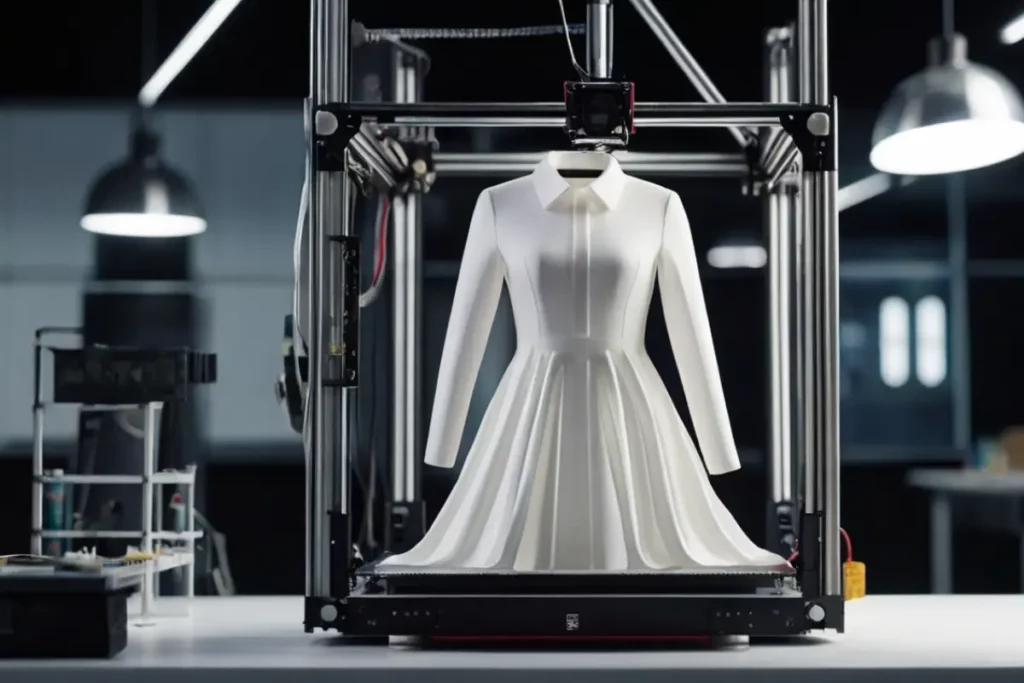
In the vast landscape of fashion, innovation has always been the heartbeat driving its evolution. From the tailored elegance of yesteryears to the fast-paced trends of today, the journey of clothing has been an ever-evolving narrative. Now, on the horizon of fashion’s frontier, emerges a revolution that promises to reshape the very fabric of how we conceive and wear attire: the advent of 3D clothing.

History of 3D Clothing
Origins: The roots can be traced back to the early experiments with additive manufacturing technologies in the 1980s. Initially utilized in industrial settings for prototyping and production, these techniques laid the groundwork for the eventual fusion of technology and fashion.
Early Experiments: In the early 2000s, pioneering designers began exploring the possibilities of 3D printing in clothing design. Dutch fashion designer Iris van Herpen emerged as a trailblazer in this field, pushing the boundaries of traditional fashion with her avant-garde creations. Her innovative use of 3D printing techniques showcased the potential of technology to transform the way we conceive and create garments.
Over the past decade, 3D fashion has transitioned from the realm of experimental fashion to mainstream acceptance. Major fashion brands and retailers have incorporated 3D printing into their design and production processes, offering consumers a glimpse into the future of fashion. From customized accessories to fully 3D-printed garments, the possibilities are endless.
Central to the development of 3D clothing is the evolution of 3D modelling software. Designers utilize specialized software website such as Blender, Rhino, and Autodesk Maya to create intricate virtual garments with unparalleled precision and details and unlimited customize possibilities. These tools enable designers to experiment with shapes, textures, and structures in a digital environment, facilitating the transition from concept to creation.
Impact of 3D Clothing
Traditionally, the creation of clothing involved a meticulous process of sketching, pattern-making, and prototyping, often consuming significant time and resources. Yet, with the dawn of 3D clothing, designers wield digital tools to navigate this process with unprecedented efficiency. Through specialized software, they sculpt virtual garments with intricate precision, accelerating design phases and fostering boundless creative exploration.
A cornerstone of 3D clothing lies in its capacity for customization. Traditional manufacturing often caters to mass production, resulting in a homogenized approach to sizing and style. However, 3D printing technology offers a bespoke alternative, tailoring garments to individual measurements and tastes. This shift towards personalized apparel not only helps enhances comfort but also helps celebrate diversity, accommodating a spectrum of body shapes and fashion preferences.
Beyond its personalized touch, 3D fashion also champions sustainability in an industry fraught with environmental concerns. Traditional garment production takes a toll on resources, from water consumption to chemical waste. Conversely, 3D clothing printing minimizes waste by utilizing materials judiciously, curbing the fashion industry’s carbon footprint. Moreover, on-demand production reduces overstock, forging a path towards a more sustainable and efficient fashion ecosystem.
Future Outlook
The realm of 3D in clothing is not solely practical; it is a playground for artistic exploration. Liberated from the constraints of conventional textiles, designers venture into uncharted territories of materiality and form. From avant-garde structures to ethereal textures, 3D clothing transcends the boundaries of wearable artistry, ushering in an era where fashion is an expression of boundless imagination.
Moreover, the impact of 3D clothing reverberates beyond the runway, infiltrating domains such as medicine and athletics. In healthcare, 3D-printed garments can serve therapeutic functions, aiding rehabilitation or providing support for medical conditions. In sports, athletes benefit from tailored 3D-printed gear, enhancing performance while minimizing injury risk. The versatility of 3D clothing extends far beyond aesthetics, offering practical solutions to real-world challenges.

As 3D clothing gains momentum, its accessibility burgeons, democratizing a once-elitist concept. What once seemed confined to the realm of high fashion now trickles down to everyday consumers. As technology advances and production costs plummet, 3D fashion inches closer to becoming a household staple, heralding a future where innovation and individuality converge in closets worldwide.
Nevertheless, amidst its promise, 3D fashion confronts challenges. Technical limitations, such as printing speed and material durability, necessitate refinement. Questions regarding scalability for mass production linger, demanding innovative solutions. Yet, as history attests, where there is innovation, there is progress. With each hurdle surmounted, 3D fashion inches closer to realizing its transformative potential.
Conclusion
In summation, the evolution and impact of 3D clothing signify a seismic shift in the fashion landscape. From redefining the design process to championing sustainability and fostering creative expression, 3D fashion heralds a new era of sartorial innovation. As we embrace this next dimension of fashion, we embark on a journey towards a more personalized, sustainable, and technologically advanced future of clothing.





Leave a Reply